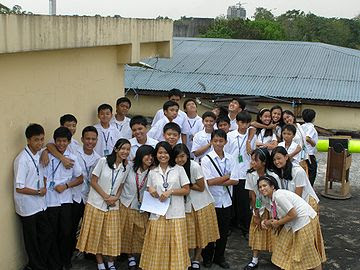
අධ්යාපනය යනු වියුක්ත සංකල්පයක් වන බැවින් ඒ සඳහා පැහැදිලි නිර්වචනයක් සැපයීම අපහසුය.අනෙක් අතට අධ්යාපනය යන්නෙන් එක් අදහසක් පමණක් අන්තර්ගත නොවේ.ඉගෙනීම, ඉගැන්වීම, ඇගයීම,රසවිඳීම,පුහුණූව ආදී විවිධ අදහස් සමුදායක් මේ තුළ ගැබ් වී ඇත. මේ නිසාද අධ්යාපනයට පැහැදිලි නිර්වචනයක් දීම අපහසු වී ඇත. විවිධ දාර්ශනිකයන් විසින් විවිධාකාර දෘෂ්ටිකෝණයන්ගෙන් අධ්යාපනය පිළිබඳව නිර්වචන ඉදිරිපත් කොට ඇත.
අධ්යාපනය යන්න මුලින්ම බි ආවේ ලතින් භාෂාවෙනි. (e-ducere, educo) පිටතට ඇදල ගැනීම යන අර්ථය e-ducere තුළ ඇත. සෑම පුද්ගලයකු සතුවම විභව ශක්තියක් ඇති බව පවසයි. අධ්යාපනයේ කාර්යභාරය වන්නේ මෙකී සැඟවී ඇති හැකියාවන් ඇදගැනීමයි. වර්තමානයේ මේ අගය 5% හෝ 10% යැයි පැවසේ.
අධ්යාපනය සම්බන්ධයෙන් ඇති විවිධ අර්ථකථන
- අධ්යාපනය යනු දැනුම ඒකරාශී කරන ක්රියාවලියකි.
සොක්රටීස් පවසා ඇත්තේ උසස්ම දෙය දැනුම බවයි.දැනුම ඇත්තා උසස්ම පුද්ගලයාය. එය ලබන්නේ අධ්යාපනයෙනි.
- අධ්යාපනය යනු වර්ධනීය ක්රියාවලියකි.
අධ්යාපනය යනු වර්ධනීය, යාවජීව ක්රියාවලියක් බව ජෝන් ඩුවී පවසයි. පුද්ගලයා හා පරිසරය අතර අන්යොන්ය සම්බන්ධයක් ගොඩනැගෙද්දී ඒ හා ගොඩනැගෙන අත්දැකීම් වල ප්රතිඵලයක් ලෙස වර්ධනය සිදුවේ.
- අධ්යාපනය යනු සංස්කෘතික සම්ප්රේෂණ ක්රියාවලියකි.
සමාජයේ සාමාජිකයකු වශයෙන් මිනිසා විසින් අත්පත් කරගනු ලබන දැනුම කුසලතා,සදාචාරය ආදි සියලුම දේ සංස්කෘතියයි. මිනිසාගේ මැදිහත්වීමෙන් නිර්මාණය වී ඇති මෙකී සංස්කෘතිය එක් පරම්පරාවක සිට තවත් පරම්පරාවක් දක්වා සම්ප්රේෂණය කරන්නේ අධ්යාපනය ඉවහල් කරගෙකය.
- අධ්යාපනය තුලින් හදවත, හිස සහ හස්තය යන තුනම (Head, Heart, Hand) සංවර්ධනය කල යුතුය.
පරමාර්ථයක් යනු කිසියම් විධිමත් ලෙස සැකසුණු ක්රියාවලියකින් අවසානයේ ඉටුකර ගැනීමට අපේක්ෂා කරන ප්රතිඵලයයි. පුළුල් සංකීර්ණ අරථයක් ගැනීම පරමාර්ථයේ ලක්ෂණයයි. මේ නිසාම එය ඉටුකර ගැනීම ඉතා දුෂ්කරය. පරමාර්ථය කරා යාමට නම් ඒවා සරළ කරගත යුතුය. ඒ සඳහා ගොඩනගාගන්නා වූ සුවිශේෂී ප්රකාශය අරමුණු ලෙස හැඳින්වේ. සුවිශේෂී බව,මැනිය හැකි බව , ළඟාවියහැකි බව ආදිය අරමුණක සුවිශේෂී ලක්ෂණ වේ. එක් පරමාර්ථයක් සඳහා අරමුණු කීපයක් පැවතිය හැක.
අධ්යාපන පරමාරථ සහ අරමුණු රටින් රටට වෙනස් වේ. එසේ වන්නේ රටක අධ්යාපන අරමුණු සහ පරමාර්ථ ගොඩනැගෙන්නේ එහි ඇති සමාජ ආර්ථීක දේශපාලන ජාතික ප්රතිපත්ති වලට අදාළ වීමයි. අධ්යාපන පරමාර්ථ ජාත්යන්තර වශයෙන් පිළිගත් ඒවාද පවතී. ඒ අතරින් යුනෙස්කෝව ප්රධාන වේ. එහි පරමාර්ථය වූයේ ජාත්යන්තර සාමය හා අවබෝධය ඇතිකරලීමයි. මීට අමතරව දිවිපැවැත්ම සඳහා අධ්යාපනය නමින් වාර්තාවක්ද පිහිටුවීය.
අධ්යාපනයේ අරමුණු පිළිබඳව කතාකරද්දී ඩෙලෝ වාර්තාවද පිළිගත් එකකි. ළමයින්ගේ විභව ශක්තිය මතුකරගන්නේ කෙසේද යන්න පිළිබඳව මෙහිදී සාකච්ඡා කළේය. මෙහිදී මූලික මූලධර්ම 6ක් යටතේ සාකච්ඡා කරයි.
- අධ්යාපනය යනු මූලික මිනිස් අයිතිවාසිකමකි.
- විධිමත් අධ්යාපනය පමණක් නොව නොවිධිමත් අධ්යාපනයද වැදගත් වන බව
- කවර අධ්යාපනයක වුවද තිබිය යුතු මූලික ලක්ෂණ ඇති බව (සාධාරණත්වය, අදාළත්වය, විශිෂ්ටත්වය)
- අධ්යාපනය යනු ගැඹුරින් සිදුකළ යුතු දෙයකි. යම් යම් රටවල ආර්ථික, දේශපාලන, සාමාජික වශයෙන් සුවිශේෂී කරුණු තිබුණද ජාත්යන්තර ප්රජාව එකඟ වූ වටිනාකම් පිළිගත යුතුයි.(ප්රජාතන්ත්රවාදය, මානව හිමිකම් )
මීට අමතරව,
-
- දැනගැනීම සඳහා ඉගෙනීම
- යමක් කිරීම සඳහා ඉගෙනීම'
- එකට ජීවත්වීම සඳහා ඉගෙනීම
- දිවිපැවැත්ම සඳහා ඉගෙනීම
ආදි ප්රධාන කුළුණු 4ක් පිළිබඳව මේ වාර්තාව අවධානය යොමුකරයි.










